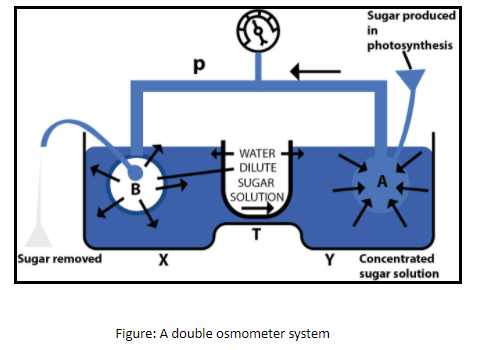
Munch hypothesis is based on
(a)Translocation of food due to turgor pressure (TP) gradient and imbibition force
(b)Translocation of food due to turgor pressure (TP) gradient
(c)Translocation of food due to imbibition force
(d)None of the above
Answer
470.7k+ views
Hint: The hypothesis states that the flow of sap (carbohydrates) into the phloem is controlled by the osmotic pressure gradient (the process of movement of particles in a gas or solvent from where they are high in number to where they are low in number).
Complete answer:
The Munch hypothesis is based on the translocation of food due to the turgor pressure(TP) gradient. This can be explained by a double osmometer system.
Two bulbs A and B made of semi-permeable membranes are connected by a glass tube. The bulb A contains a concentrated sugar solution and the bub B contains a dilute solution. Both the bulbs are kept in a vessel containing water. The bulb absorbs the water and its turgor pressure rises. Due to this, there is a flow of water towards bulb B along with food material. This process continues until an equilibrium is reached.

The above example can be compared to plants in a manner that carbohydrates are produced in the leaves (bulb A) of the plant in the mesophyll cells, which increases its turgor pressure. After sufficient turgor pressure is developed the carbohydrates are transferred from a region of higher concentration to the region of lower concentration, where it is required. The cell membrane in the plants acts as a semipermeable membrane.
Additional Information:
-The Munch hypothesis was put forward by Ernst Munch in 1930.
-Turgor pressure is the pressure exerted by a fluid in the cell towards the cell wall.
So, the correct answer is, ‘Translocation of food due to turgor pressure (TP) gradient.’
Note: The food material is transferred through the phloem along the concentration gradient. From the source, where the food is prepared, to sink, where it is stored. The munch flow hypothesis is also known as the mass flow hypothesis.
Complete answer:
The Munch hypothesis is based on the translocation of food due to the turgor pressure(TP) gradient. This can be explained by a double osmometer system.
Two bulbs A and B made of semi-permeable membranes are connected by a glass tube. The bulb A contains a concentrated sugar solution and the bub B contains a dilute solution. Both the bulbs are kept in a vessel containing water. The bulb absorbs the water and its turgor pressure rises. Due to this, there is a flow of water towards bulb B along with food material. This process continues until an equilibrium is reached.

The above example can be compared to plants in a manner that carbohydrates are produced in the leaves (bulb A) of the plant in the mesophyll cells, which increases its turgor pressure. After sufficient turgor pressure is developed the carbohydrates are transferred from a region of higher concentration to the region of lower concentration, where it is required. The cell membrane in the plants acts as a semipermeable membrane.
Additional Information:
-The Munch hypothesis was put forward by Ernst Munch in 1930.
-Turgor pressure is the pressure exerted by a fluid in the cell towards the cell wall.
So, the correct answer is, ‘Translocation of food due to turgor pressure (TP) gradient.’
Note: The food material is transferred through the phloem along the concentration gradient. From the source, where the food is prepared, to sink, where it is stored. The munch flow hypothesis is also known as the mass flow hypothesis.
Recently Updated Pages
Master Class 11 Accountancy: Engaging Questions & Answers for Success

Glucose when reduced with HI and red Phosphorus gives class 11 chemistry CBSE

The highest possible oxidation states of Uranium and class 11 chemistry CBSE

Find the value of x if the mode of the following data class 11 maths CBSE

Which of the following can be used in the Friedel Crafts class 11 chemistry CBSE

A sphere of mass 40 kg is attracted by a second sphere class 11 physics CBSE

Trending doubts
10 examples of friction in our daily life

One Metric ton is equal to kg A 10000 B 1000 C 100 class 11 physics CBSE

Difference Between Prokaryotic Cells and Eukaryotic Cells

State and prove Bernoullis theorem class 11 physics CBSE

What organs are located on the left side of your body class 11 biology CBSE

The combining capacity of an element is known as i class 11 chemistry CBSE




